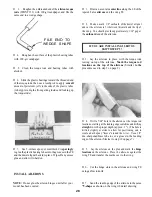
Keep items such as these away from the prop: loose
clothing, shirt sleeves, ties, scarfs, long hair or loose
objects (pencils, screw drivers) that may fall out of shirt or
jacket pockets into the prop.
Use a "chicken stick" device or electric starter; follow
instructions supplied with the starter or stick. Make certain
the glow plug clip or connector is secure so that it will not
pop off or otherwise get into the running propeller.
Make all engine adjustments from behind the rotating
propeller.
The engine gets hot! Do not touch it during or after
operation. Make sure fuel lines are in good condition so
fuel is not leaked onto a hot engine causing a fire.
To stop the engine, cut off the fuel supply by closing
off the fuel line or follow the engine manufacturer's
recommendations. Do not use hands, fingers or any body
part to try to stop the engine. Do not throw anything into
the prop of a running engine.
I will perform my initial turn after takeoff away
from the pit, spectator and parking areas, and I
will not thereafter perform maneuvers, flights of
any sort or landing approaches over a pit, specta-
tor or parking area.
3.
FLYING
The Great Planes FUN-ONE is a great flying sport
airplane that flies smoothly and predictably, yet is highly
maneuverable. It docs not have the self-recovery charac-
teristics of a primary trainer, therefore you must either
have mastered the basics of R/C flying or seek the assis-
tance of a competent R/C pilot to help you with your first
flights.
AMA SAFETY CODE
Read and abide by the following Academy of Model
Aeronautics Official Safely Code:
GENERAL
1. I will not fly my model aircraft in competition or
in the presence of spectators until it has been
proven to be airworthy by having been previously
successfully flight tested.
2. I will not fly my model aircraft higher than
approximately 400 feet within 3 miles of an airport
without notifying the airport operator. I will give
right of way to, and avoid flying in the proximity
of full scale aircraft. Where necessary an ob
server shall be utilized to supervise flying to
avoid having models fly in the proximity of f u l l
scale aircraft.
3. Where established, I will abide by the safety rules
for the flying site I use, and I will not willfully and
deliberately fly my models in a careless, reckless
and/or dangerous manner.
RADIO CONTROL
1. I will have completed a successful radio
equipment ground check before the first flight of
a new or repaired model.
2. I will not fly my model aircraft in the presence of
spectators until I become a qualified flyer, unless
assisted by an experienced helper.
TAKEOFF: If you have dual rates on your transmit-
ter, set the switches to "low rate" for takeoff. Although the
FUN-ONE has great low speed characteristics, you should
always build up as much speed as your runway will permit
before lifting off, as this will give you a safety margin in
case of a "flame-out". When you first advance the throttle
and the tail begins to lift, the plane will start to turn left (due
to engine torque and P-Factor). Be ready for this, and
correct by applying sufficient right rudder to hold it
straight down the runway. The lefl-turning-tendency will
quickly go away as soon as the tail is up and the plane picks
up speed. When the plane has sufficient flying speed, lift
off by smoothly applying a little up elevator (don't "jerk"
it off to a vertical climb!), and climb out gradually.
FLYING; We recommend that you take it easy with
your FUN-ONE for the first several flights and gradually
"get acquainted" with this fantastic ship as your engine
gets fully broken-in. Practice one maneuver at a time,
learning how she behaves in each one. For ultra-smooth
flying and normal maneuvers, we recommend using the
"low rate" settings as listed on page 33 . "High rate"
elevator and rudder may be required for crisp snap rolls
and spins. "High rate" rudder is best for knife edge.
Speed is the key to good knife-edge performance. Do not
exceed the recommended "high rate" throws for the eleva-
tor, as this will only result in unstable flight when full
elevator is applied.
You will learn many interesting maneuvers by just
flying the FUN-ONE and trying different things. The one
thing to keep in mind while "free-style" flying like this is
to always stay in control and think about the control inputs
so you don't gel disoriented.
38
Содержание FUN-ONE
Страница 5: ...5...



































